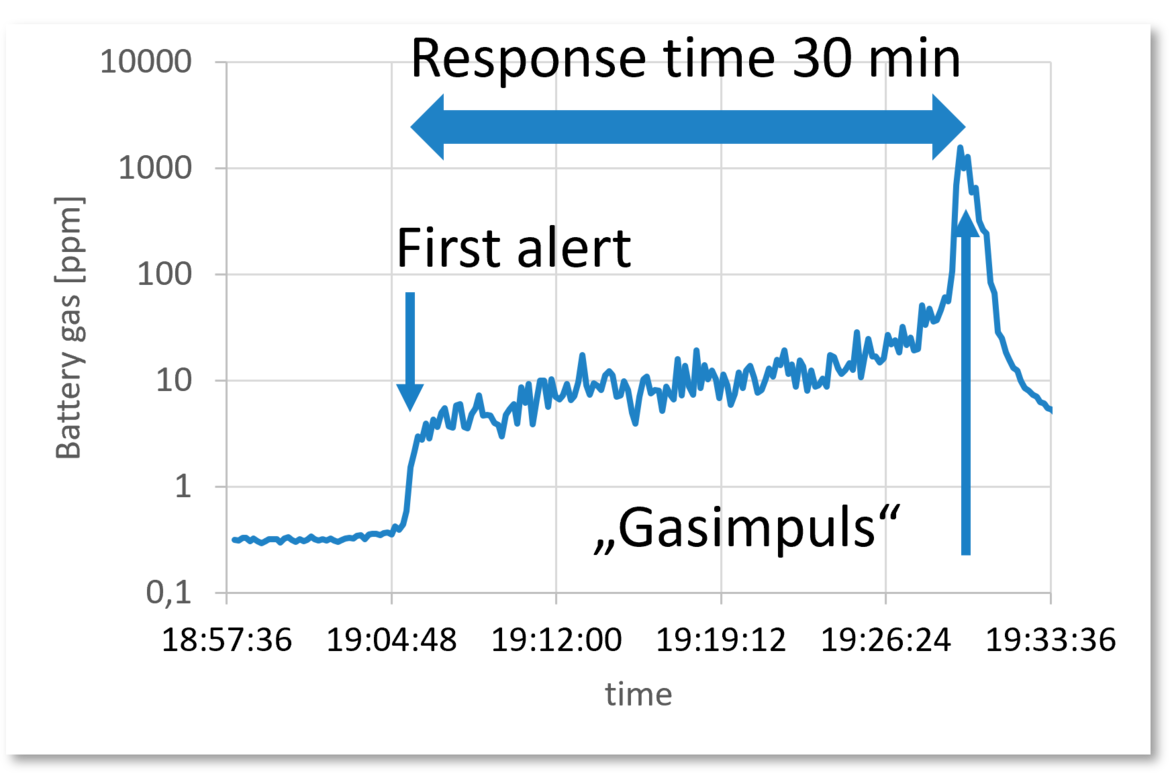Gas detection makes battery logistics safer
Sensor technology plays a key role in the detection of critical battery conditions: in the transfer project with the Battery Logistics Innovation Lab. We were able to further develop our gas sensor from the Monilog® data logger portfolio. Artificial intelligence was also used for the reliable detection of gases that typically escape in the event of a battery damage.
The detection of safety-critical lithium batteries plays an important role in logistics. While the topic naturally plays a subordinate role for new batteries, it is becoming increasingly important for older, discarded batteries - especially in view of the mass spread of electromobility. As long as batteries are in the car, the battery management system (BMS), as the electronic control unit of the battery, warns of a possible thermal runaway. Dismantled batteries that make their way into second life, for further use or recycling, must be monitored differently. At present, non-contact infrared temperature measuring devices are generally used here. However, temperature measurements on batteries reach their limits if they cannot look directly at the battery surface or if the battery surface is not accessible. An alternative is the use of gas sensors. This is because battery failures are not only signalled by a rise in temperature, but also by the emission of so-called harmful gases, including carbon dioxide, carbon monoxide, hydrogen and short-chain hydrocarbons.
Objectives of the transfer project
-
Proof of sensor functionality in terms of measurement accuracy for hydrogen and hydrocarbons, verification of sensor functionality using real battery tests
-
Proof of the reproducibility and selectivity of the target gas detection
-
Definition of a time span from the time of detection of an incipient accident until the battery has been completely run through under defined boundary conditions
-
Derivation of limit values for specific gas concentrations above which a thermal runaway is certain or likely to occur
For the industrial use of these gas sensors in battery logistics, however, there was a lack of proof of sensor functionality. The usual reaction gases of a thermal runaway are difficult to generate outside of laboratory conditions. Therefore, a realistic test setup was required for the teach-in of gas measurement sensors. Cicor was able to carry out precisely these tests as part of an InnoLogBat transfer project with a team of researchers at the Fraunhofer Heinrich Hertz Institute HHI, one of InnoLogBat's scientific partners. At the Battery and Sensor Test Centre of the Fraunhofer HHI and Clausthal University of Technology in Goslar, numerous tests and test series with different gas sensors and different setups were carried out within a few months.
30 minutes to the Thermal Runaway
In the first series of tests, it was already possible to provide basic proof that the Monilog® solution can clearly recognise a developing battery accident by measuring the outgassing. To this end, the sensors were first exposed to gases that are typically released during an accident. They were then trained using machine learning to recognise these gases in different concentrations. At the same time, the sensors were also tested with atypical gases in order to determine cross-sensitivities.
Testing and adapting technologies for use in battery logistics is an important concern for us in the research project.. Leonard Kropkowski, Fraunhofer HHI
In a final series of tests the thermal runaway of a battery was specifically induced in a first set-up by charging and heating cells. In a second set-up, the cells were only charged and heated to such an extent that gas formation was induced in the cells (visible swelling of the cells), but without thermal runaway. In both cases, outgassing of the cells was observed. This showed that the Monilog® GasSensor used can reliably detect the typical gases hydrogen and hydrocarbons that escape from critical lithium-ion batteries, even in contaminated environments. Learned gas compositions were reliably recognised so that cross-influences from other "gas sources", which lead to false alarms, are avoided. Early detection of up to 30 minutes before a thermal runaway occurs in a critical lithium-ion battery has also been demonstrated.
The collaboration with the researchers at the Battery Logistics Innovation Lab has significantly enhanced our product and our team. All the objectives of the transfer project were achieved. Dr. Ronny Leuschner, Head of Monilog®, Cicor
Gas detection is an important component
The industry is showing great interest in the development, especially battery manufacturers, recycling companies or companies for the reprocessing and secondary utilisation of lithium-ion batteries. Gas detection is an important technological safety component for monitoring lithium-ion batteries. Damages are recognised more quickly and misdetections are avoided at the same time. The prototype of the new data logger is already running successfully in pilot operation at several customers and is being developed further on a regular basis.



